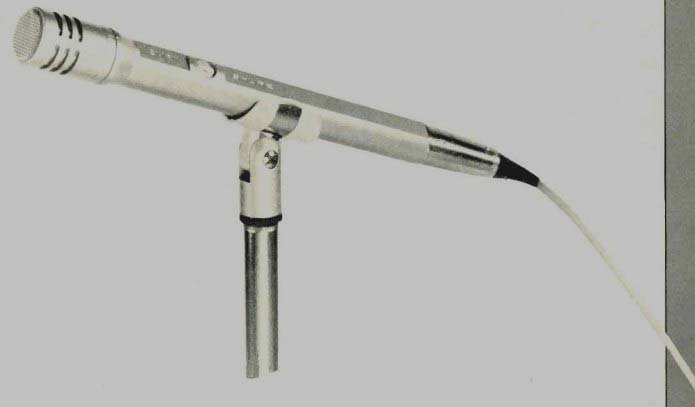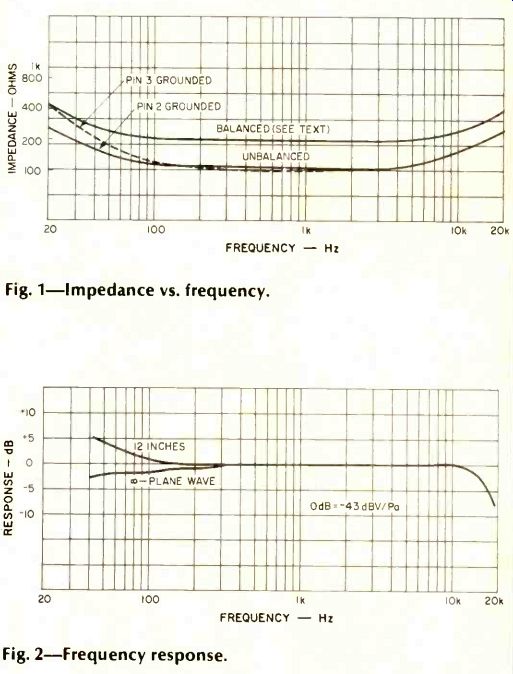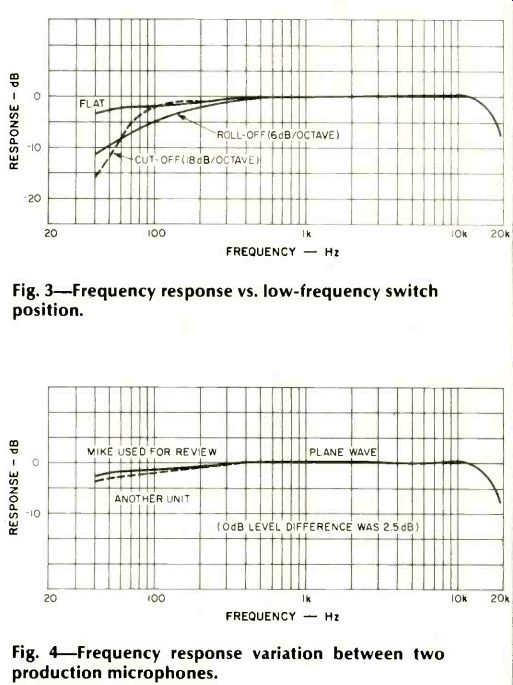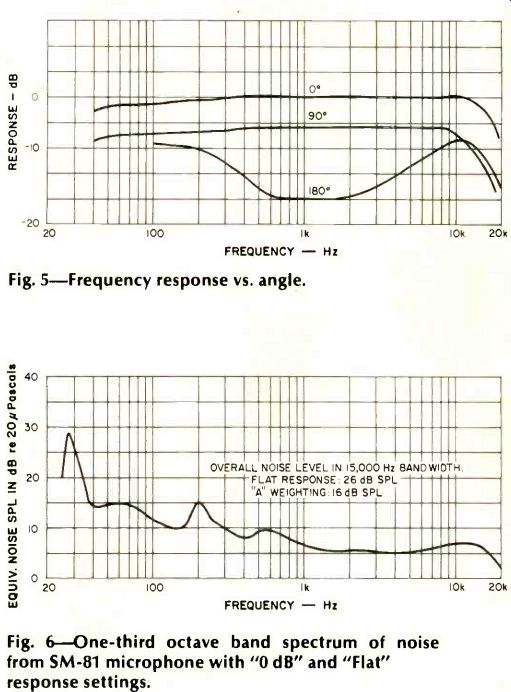
Manufacturer's Specifications
Type: Cardioid condenser (electret bias).
Frequency Response: 20 to 20,000 Hz.
Polar Pattern: Cardioid.
Output Impedance: Rated, 150 ohms; actual, 85 ohms.
Recommended Load Impedance: 800 ohms minimum.
Output Level at 1 kHz: Open circuit voltage,-64 dB (0.63 mV), 0 dB = 1 V/microbar; power level,-39.5 dB, 0 dB = 1 mW/10 microbars.
Maximum Input Level: With 800-ohm load at 1 kHz, 135 dB with attenuator at 0, 145 dB with attenuator at 10.
Hum Pickup: Typical, -4 dB equiv. SPL in a 1 millioersted field; -144 dB re: 1 mW in a 0.001-Gauss, 60-Hz magnetic field with 150-ohm load.
Noise Level: 16 dB typical, "A" weighted; 19 dB typical, DIN 45 405 weighted.
Phasing: Pin 2 is plus.
Low-Frequency Response Compensation: Three position switch; flat,-6 dB/octave below 100 Hz (roll-off), or-18 dB/octave below 80 Hz (cut off).
External Power Required: Simplex (phantom) system, 12 to 48 V d.c. at 1.25 to 1.75 mA.
Environmental:-29 to +57 degrees C, 0 to 95 percent R.H., integral r.f. filter.
Case: Steel with metallic vinyl finish.
Dimensions: Overall, 15/16 in. (23.5 mm) dia. by 8-11/32 in. (212 mm) L.
Weight: 8 oz. (230 g).
Cable: 25.3 ft. (7.6 m).
Accessories Furnished: Pop screen, 49A41; swivel adaptor, A57D; 10-dB attenuator lock, 34A830.
Accessories Available: Power supply PS-1, $113.40; external pad A15AS, $27.60; 14-ft. tripod stand S15, $89.40; windscreen A81WS, $18.75; stereo mike adaptor A27M, $22.05.
Price: $250.00.
The Shure SM-81 is a high-quality electret system designed for studio recording, broadcasting, and sound reinforcement applications. In addition, the microphone and accessories comprise a complete system that is suitable for on-location music recording by audiophiles. The microphone may be permanently installed in inaccessible locations since d.c. power is supplied remotely. The phantom (or, as Shure terms it, Simplex) powering scheme allows ordinary two-wire shielded microphone cable to be used between the micro phone and the unit providing power. (This scheme has been discussed in previous reviews of air condenser [non-electret) microphones.) The condenser capsule unscrews from the preamp and may be quickly replaced. This feature is common to the several condenser microphones we have reviewed in Audio, but the SM-81 is the only one (at this writing) that lacks alternative capsules An integral 10-dB attenuator is provided between head and preamp and is selected by a rotating ring behind the capsule. This switch may be locked by the accessory provided. The attenuator reduces the output of the capsule, preventing clipping of the preamp on very loud sounds (above 135 dB SPL). If, on the other hand, the user's input amplifier is being overloaded, the problem may be solved by using the 10-dB pad at the expense of a 10-dB loss in S/N or, more properly, by using an external pad, such as Shure's newly introduced A15AS.
Many recording locations have low-frequency rumble that is picked up by condenser microphones having uniform frequency response to 20 Hz and below. (As a matter of fact, we have not yet found a site that will permit us to use the low frequency boost equalizer designed for another condenser microphone--see Audio, September 1978.) The low-frequency response of the SM-81 may be varied by the integral three-position switch. This built-in filter is an advantage to the audiophile who does not have suitable filters or equalizers in the mixer or recorder. A low-frequency response equalizer may also be used to compensate for "proximity effect," which is the bass boost exhibited by pressure-gradient micro phones when the sound source is closer than three feet. Figure 8 of the instructions shows that the middle switch position does provide compensation for a source distance of six inches.
The preamp includes an r.f. filter at the connector which is good for broadcast stations and recording sites with high r.f. interference.
The machined-steel housing appears to be as durable as an iron pipe, and may contribute to the very low sensitivity stated for magnetic hum pickup. The specifications omit a reference to frequency and Shure confirms it is for 60 Hz; hum sensitivity normally increases with frequency. The case finish is a vinyl paint which looks exactly like nickel plating over an abrasive blasted surface, and seems to have similar resistance to scuffs.
Laboratory Measurements

Fig. 1--Impedance vs. frequency.
Fig. 2--Frequency response.
We would like to remind the reader that all measurements were conducted in accordance with our articles on micro phone testing in the April 1977 and September 1978 issues of Audio.
All tests on the SM-81 were made using a PS-1 power sup ply. The impedance test produced the curious results shown here in Fig. 1. The "unbalanced" measurement yielded 100 ohms at 1 kHz, which is close enough to the 85 ohms specified for actual impedance. The "balanced" test was conducted similarly except a 200-ohm isolation transformer was inserted with primary windings ungrounded. The instructions do not state what input circuit configurations may be used, although the minimum load Z (800 ohms) is specified. We questioned the factory engineers who indicated the SM-81 may be used with balanced or unbalanced leads. Normally we use a broadcast-type amplifier with a grounded center tap on the input transformer. Careful acoustic tests revealed that the SM-81 frequency response and sensitivity had no measurable variation when our input transformer strapping was varied between unbalanced, balanced-floating, and balanced-CT grounded. (Editor's Note: Shure tells us that the impedance vs, frequency data, presented in Fig. 1, do not agree with their laboratory measurements for the balanced condition. In addition, they do not achieve different results at low frequencies for an unbalanced condition depending on grounding pin 2 or 3. Their data indicate that as long as the microphone electronics are not overloaded, the output impedance will go up very slightly, approximately seven ohms, as measured in a balanced as compared to an unbalanced state when measured through a PS-1 power supply. This difference is a result of creating an a.c. short [unbalanced condition] across one of the two biasing resistors in the PS-1. However, the actual output impedance of the microphone is not changed. In reviewing the statement regarding the balanced measurement, Shure is concerned about the influence of the 200-ohm isolation transformer, since a transformer is not required for such measurements.)
The frequency-response curve (Fig. 2) indicates that for most practical source distances, the low-frequency response will be flat to very low frequencies, or substantially bass-boosted. Figure 3 illustrates the measured response compensation. The center switch position provides linear response at 12 in. as predicted earlier. At 50 Hz we measured 7.5-dB attenuation with the Rolloff setting and 12.5 dB with the Cut off setting. This agrees with Fig. 1 of the data sheet, but disagrees with the attenuation values of Fig. 8, which we think is in error. (Editor's Note: Shure tells that later printings of the data sheet will agree with the differences shown in Fig. 1 of the sheet.) We tested two microphones for axial frequency response, and Fig. 4 shows the performance of the units. The low-frequency differences were insignificant. There were no variations in high-frequency response, except for the roll-off above 15 kHz, which is quite remarkable. The data sheet shows this roll-off with somewhat higher response levels, from 15 kHz to 20 kHz. (Editor's Note: Shure's published frequency response curves are based upon free-field measurement using a Bruel and Kjaer Model 4133 flat free-field con denser microphone and disagree with the review measurements at 20 kHz by approximately 3 dB, Shure's data showing a higher level.) This phenomenon is easy to understand, be cause a pressure microphone of 24-mm diameter (example: W.E Co. 640AÁ) exhibits a similar high-frequency response variation.
Figure 5 shows that the 90-degree response rolls off above 10 kHz and the 180-degree response tends toward omnidirectional properties at high frequencies. Both phenomena are presumably related to the microphone diameter. (Refer to Audio, September, 1978, pg. 91 for an example of improved linearity in high-frequency characteristics with a 16-mm diameter capsule.) The 180-degree response has a good (20 dB) null at 1 kHz, but measures 10 dB or less at 100 to 200 Hz. The polar pattern in the data sheet shows that the cancellation is reduced to 15 dB at 100 Hz. The difference may be attributed to imperfections in our indoor test setup where we usually cannot achieve more than about 15 dB front-to-back ratio below 500 Hz even with a microphone. We might have been able to measure better than 10 dB with our more accurate outdoor setup (Audio, September, 1978). (Editor's Note. Shure comments that the low-frequency response is greatly influenced by the nature of the sound field presented to the microphone. If, for example, the sound field were truly free field, equivalent to being a very large distance from a point source, the 180-degree response measured at 1 kHz would continue to hold down to an extremely low frequency.)
Figure 6 shows the major advantage of a 24-mm diameter microphone: Low equivalent-input-noise level. This results from large diaphragm area (and correspondingly high electrostatic sensitivity) plus a very low-noise discrete semiconductor preamplifier. The 16 dB "A" weighted equivalent SPL noise level is lower than any value we've previously measured for a microphone of this size. Our results agree exactly with the revised data supplied by Shure. (Originally, higher values had been specified.) The noise of the SM-81 is so low that the user should take care in selecting a suitably low noise mixer so that S/N is controlled by the microphone and not by the mixer.
The phase test showed pin #2 is positive, as specified, and clipping levels were essentially the same as specified. The hum sensitivity was about 15 dB less than our reference microphone, and we estimate that the SM-81 meets specifications. The SM-81 is very insensitive to magnetic hum and can probably be used in many places where other microphones would have objectionable hum.

Fig. 3--Frequency response vs. low-frequency switch position.
Fig. 4--Frequency response variation between two production microphones.
Listening and Use Tests
In past reviews we have employed a broadcast-quality cardioid ribbon microphone as a reference for listening comparisons. In our review of the Nakamichi CM-700 (16-mm diameter) electret condenser microphone (Audio, September 1978), we noted that our reference ribbon microphone was substantially inferior at very high frequencies. The CM-700 system includes both cardioid and omni capsules. Since the response of the omni capsule met ANSI specifications for 13 mm (1/2 in.) laboratory microphones, we concluded that this system would be excellent as a listening reference for future reviews of omnidirectional as well as cardioid microphones. (We are not implying that the CM-700 system is superior to all other microphones. It has very uniform response and directivity with respect to frequency, but has many practical disadvantages such as lack of remote powering, higher noise level, and delicate-looking condenser heads.) We used the CM-701 cardioid head for comparison to the SM-81.
Without a windscreen or pop-screen, the SM-81 is very sensitive to wind and "pop," and will "thump" when moved about in still air. "Pop" sensitivity is higher than the reference cardioid microphone when each is covered with its small pop-screen. The SM-81 had "pop" sensitivity equal to the reference microphone when the Lo Cut switch was set for maxi mum attenuation (reference microphone on "flat" response). The large Shure windscreen eliminated "pop," but not "thump." The higher wind sensitivity of the SM-81 is a logical result of its extended low-frequency response, but we are a little concerned about the "thump," which might happen outdoors or in a drafty room. Subjectively, the "thump" sounded like blocking of the first stage in the microphone electronics. We questioned the manufacturer who indicated they experienced similar effects and traced it to overloading of the mixer or tape recorder input stage. They stated that if "thump" is heard, it can be eliminated by reducing the microphone output level with the integral attenuator or a separate pad ahead of the mixer.
Vibration and handling noise proved to be significantly lower than the reference microphone..
Laboratory listening tests were conducted with voice and acoustic guitar. On axis the SM-81 sounds the same as the reference mike with voice, but at 90 degrees off axis it sounds more muffled. With guitar, we heard somewhat less high-frequency overtones on axis and much less overtones at 90 degrees off axis. Proximity-effect compensation is effective at 12 in. as shown by tests, and the voice sounds "boomy" at six in. or closer.
(Editor's Note: Shure comments that the SM-81 has flat and extended on-axis high-frequency response, and that this response shape is also maintained at other angles of sound incidence including random incidence. In an A-B test with another microphone, listening comments indicate that the other microphone has a peaked-up high-frequency response, and that this peak is further emphasized as the comparison microphone is moved 90 degrees off axis.)
We had the opportunity to record a string quartet plus piano with a pair of SM-81s mounted on the S15 stands, and used with PS-1 power supply plus Shure A95UF transformers into a ReVox A77 recorder. The musicians would not permit a single S15 stand in front of the group, so we couldn't try out the A27M stereo microphone adaptor (which we found to be a cleverly designed accessory). The SM-81s were 14 ft. above the musicians in the chancel area of a large, reverberant (RT60=3 S) church. The acoustic environment was totally inappropriate for chamber music, but the SM-81s reduced the perceived RT to very acceptable values. We were privileged to have the tape auditioned by a distinguished patron of the arts who is also an accomplished cellist. Until we in formed him to the contrary, he assumed the recording was made in a smaller room with relatively dead acoustics. He praised the audio quality which he indicated was limited only by the fact that the instruments were not top-quality, such as Stradivarius and the like. In this instance, the micro phones were far enough above the musicians that no instrument was more than about 20 degrees off axis. Lacking an A B test with the reference microphone, any lack of top-octave overtones were not noticed, even by the expert. For this re cording, we used the capsule attenuator "improperly" to re duce microphone sensitivity so that knob settings on the ReVox would be "normal." The degradation in S/N was not noticed above ambient room noise or tape noise.
The S15 stands are quite remarkable pieces of hardware. Although they extend to 14 ft., they collapse to about 3 ft. and fit into a soft carrying case that can be carried aboard an airliner. We have used one for environmental noise testing in locations ranging from Puerto Rico to Chicago. We have only one minor complaint-the tube section rattles and was first heard outdoors in Puerto Rico where the wind velocity was 10 to 15 knots all day. We later tried the S15s with the reference microphones to record a concert and thought that the sound quality was significantly improved over previous recordings with these mikes. This was a dramatic demonstration that positioning can be relatively more important to good audio than the choice of microphone (when each is a high-grade professional unit).

Fig. 5--Frequency response vs. angle.
Fig. 6--One-third octave band spectrum of noise from SM-81 microphone with "0 dB" and "Flat" response settings.
Conclusions
We are very pleased with the biomechanics and potential durability of the SM-81. The case is not easily marred, and the flat surface protects the Lo Cut switch and also prevents rolling. The switches are easy to operate without tools, and the front screen is very rigid and not easily dented.
We would like to see an omnidirectional capsule available for this system, since it would be useful in many instances for preserving natural ambience of auditoriums, as well as for vocal and hand-held applications. An omnidirectional micro--phone simplifies close miking of instruments, although some will argue that it reduces the acoustic isolation between instruments.
We can recommend the SM-81 for all pop music applications because it is particularly suited for high SPL in close miking and has integral low-cut filters. It can be used for very close vocal pickup in combination with an external proximity-effect equalizer, as well as for hand-held vocals. If "thump" is a problem in this latter use, the integral attenuator or external pad will eliminate it. In classical music pickup, it is well suited to permanent installations where the micro phone is "flown" high above the orchestra and where high pitched instruments, such as strings or harpsichord, are not far off axis. The SM-81 is also especially suited to sound pick up of low SPL instruments, such as the virginal and clavichord, because of its low noise level. Undoubtedly, it will be a problem solver for high electromagnetic and r.f. interference locations.
-Jon R. Sank
(Source: Audio magazine, Aug. 1980)
Also see:
Shure SM85 Unidirectional Condenser Microphone (Equip. Profile, May 1982)
Shure Model 516EQ Microphone (Apr. 1977)
Shure SM91 Microphone (Equip. Profile, Jun. 1986)
Shure SM89 Shotgun Condenser Mike (Dec. 1990)
Sennheiser MKH 40 Microphone (Equip. Profile, Jan. 1988)
= = = =